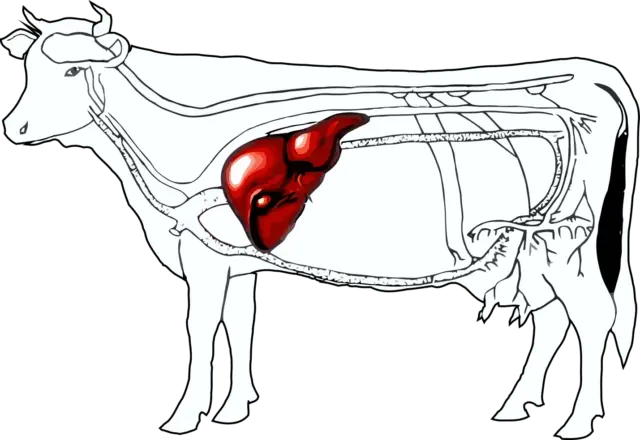Contents
Hepatosis in cattle is the general name for liver diseases, which are characterized by degenerative changes in the parenchyma in the absence of inflammatory processes. At the same time, general intoxication and a violation of the main functions of the organ are observed.
Classification of hepatoses
The development of hepatosis is associated with metabolic disorders in cattle. This is a group of non-communicable diseases of various etiologies. It is divided into granular, amyloid, carbohydrate and fatty form of dystrophy.

Pathological dysfunctions are diverse, often depending on the nature of hepatosis, but, as a rule, are accompanied by degenerative changes in the liver of cattle. The process of dystrophy can begin from the edges of the lobule, sometimes from the center or from all the lobules at once. Moreover, if the stroma of the organ remains intact, then the changes are most often reversible and can be corrected, and with more severe pathologies, as a rule, coma occurs.
The diagnosis of toxic liver dystrophy in cows is hepatosis of toxic origin. Differs in general intoxication, initial processes of damage in cells. If the disease proceeded in an acute form, then at autopsy the organ is flabby, slightly enlarged in size. In the case of a chronic course of the disease, the organ is of normal size or slightly reduced. The pattern is motley, there may be areas of irregular shape, a yellowish tint in some types of dystrophy. The center of the cattle lobules may undergo necrosis.
Reasons for the development of hepatosis in cattle
Among the various pathological processes in the liver of cattle, the leading ones are hepatoses, which cause economic damage to owners and farms. Financial resources are spent on the treatment of cows, which turns out to be ineffective. In addition, milk production in animals decreases, the disease often leads to infertility, and when an animal is slaughtered, the liver, which is a valuable product, must be disposed of.
The following reasons lead to the development of hepatosis in cattle:
- the lack of active walks, due to which the ketones formed in the liver are not wasted by the muscles, but accumulate in the blood and urine, this provokes the development of ketosis;
- the use of spoiled feed by animals – rotten and moldy;
- poisoning of the body of cattle with toxins of plant and animal origin;
- unbalanced feeding, the predominance of pulp and bard in the feed, which are hard to digest by the gastrointestinal tract;
- occurs as a complication after diseases of the animal’s digestive system, for example, gastritis, some infectious diseases;
- develops in diabetes.
Often the cause of the development of hepatosis in cattle is a violation of the feeding regimen of animals – excessive feeding or prolonged, regular starvation of cattle.
Symptoms of liver dystrophy in cows

Acute hepatosis develops rapidly. Clinical signs are general malaise, intoxication of the body, jaundice is manifested. Cows are strongly oppressed, weak, there is a slight increase in body temperature. Appetite may be somewhat reduced or absent altogether.
Acute liver dystrophy in cows develops before calving or in the first few days after it. The animal often lies, rises to its feet with difficulty. Tachycardia, rapid, intermittent breathing, atony of the preventricles are also determined.
In the chronic form of hepatosis, the clinical symptoms are not so pronounced. Some depression of the cow, general weakness, loss of appetite, dyspeptic disorders are noted. The liver is slightly enlarged in volume, the animal reacts negatively to palpation. Jaundice of the mucous membranes is not manifested at all or is weakly expressed. Body temperature is within normal limits.
A blood test shows a decrease in glucose, an increased content of pyruvic, lactic acid, bilirubin, and cholesterol. With toxic dystrophy, the activity of AsAT, AlAT is increased.
Pathological and morphological changes in the liver of a cow with protein-fatty degeneration consist in a significant increase in the organ. Its shade is yellow, the structure is flabby, the pattern on the cut is slightly smoothed.
With the development of chronic fatty hepatosis, the liver is also enlarged, its edges are rounded. It has a greasy, clayey appearance. Histological studies note degeneration of hepatocytes in the central part, the structure of the lobes is disorganized. With toxic dystrophy of the liver of cattle, necrotic changes are noted.
Treatment of hepatosis in cattle
First of all, the main causes of the disease are eliminated. High-quality hay, grass, tear, root crops, reverse are introduced into the diet. It is necessary to give vitamin supplements and trace elements.
Of the medicines, lipotropic, choleretic drugs, vitamin injections are used. From lipotropic appoint choline chloride, methionine, lipomide. These drugs prevent organ degeneration and fatty infiltration.
Of the means that enhance bile formation, bile secretion, magnesium sulfate, cholagon, allochol are prescribed.
Prognosis and prevention
Measures aimed at eliminating and preventing the development of hepatosis are as follows:
- daily control of feed quality, preventing animals from eating spoiled food;
- nutrition should be balanced;
- it is unacceptable to get pesticides and other fertilizers into the feed;
- the introduction of microelements, vitamin supplements, premixes into the diet of cattle, which significantly strengthen the animal’s body;
- prevention of metabolic diseases.
As a rule, with a quick response of the owner of the animal, timely assistance, qualified treatment, the prognosis of the disease is favorable.
Conclusion
Hepatosis in cattle, like many other diseases of farm animals, is much easier to prevent than to treat. Hepatosis responds well to therapy and disease prevention is simple. During treatment, you should trust an experienced specialist.









